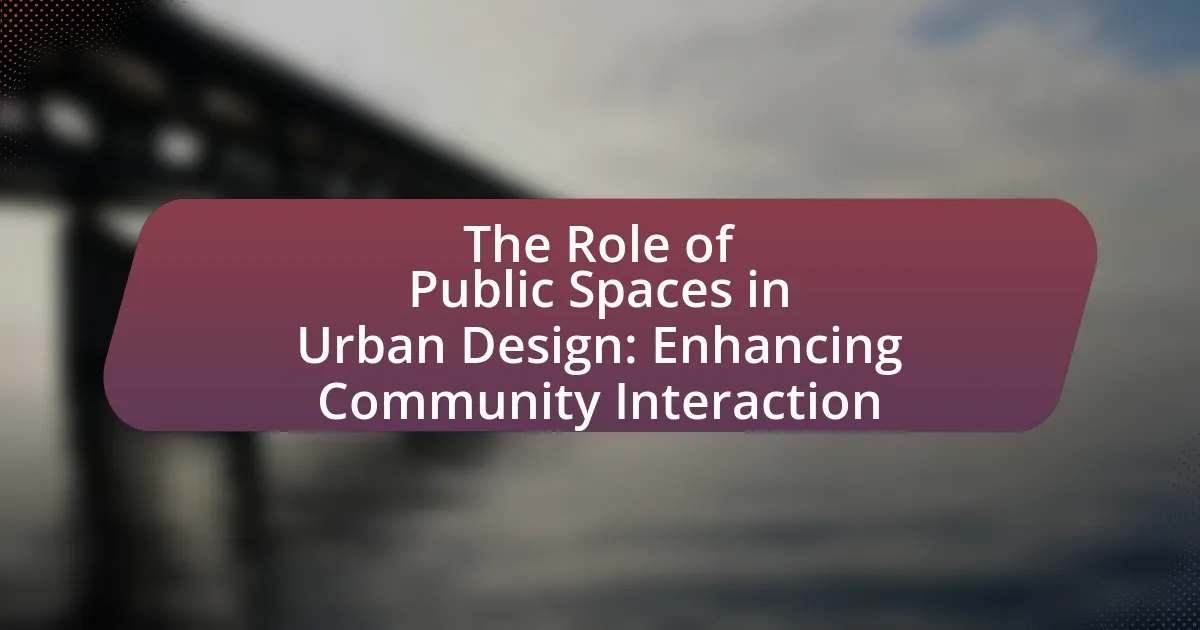Biophilic design in urban environments emphasizes the integration of natural elements into architecture and urban planning to strengthen the connection between people and nature. This approach aims to enhance well-being, reduce stress, and promote biodiversity through features such as green roofs, living walls, and natural lighting. Key principles include the incorporation of natural materials and water elements, which have been shown to improve mental health and productivity. The article explores the benefits of biophilic design, its impact on human well-being, and practical applications in urban planning, while also addressing challenges and misconceptions associated with its implementation.

What is Biophilic Design in Urban Environments?
Biophilic design in urban environments refers to the integration of natural elements into architectural and urban planning to enhance the connection between people and nature. This design approach aims to improve well-being, reduce stress, and promote biodiversity by incorporating features such as green roofs, living walls, natural lighting, and water elements. Research indicates that biophilic design can lead to increased productivity and improved mental health outcomes, as evidenced by studies showing that exposure to nature can lower cortisol levels and enhance mood.
How does Biophilic Design integrate nature into urban architecture?
Biophilic Design integrates nature into urban architecture by incorporating natural elements, such as plants, water features, and natural light, into building designs. This approach enhances the connection between people and their environment, promoting well-being and sustainability. Studies have shown that incorporating greenery in urban spaces can reduce stress and improve air quality, with a report from the World Health Organization indicating that urban green spaces can lead to a 30% reduction in stress levels among city dwellers. Additionally, biophilic design principles encourage the use of natural materials and the creation of spaces that mimic natural ecosystems, further fostering a sense of harmony between urban living and nature.
What are the key principles of Biophilic Design?
The key principles of Biophilic Design include the integration of natural elements, the use of natural light, and the incorporation of organic forms and materials. These principles aim to create environments that foster a connection between people and nature, enhancing well-being and productivity. For instance, studies have shown that access to natural light can improve mood and reduce stress, while the presence of plants can enhance air quality and promote relaxation. Additionally, incorporating water features and views of nature can further strengthen this connection, leading to improved mental health outcomes.
How does Biophilic Design influence human well-being?
Biophilic Design significantly enhances human well-being by integrating natural elements into built environments, which fosters a connection to nature. Research indicates that exposure to natural light, greenery, and water features can reduce stress, improve mood, and increase overall life satisfaction. For instance, a study published in the Journal of Environmental Psychology found that individuals working in environments with biophilic elements reported a 15% increase in well-being and productivity compared to those in traditional office settings. This evidence underscores the positive impact of Biophilic Design on mental health and emotional resilience.
Why is Biophilic Design important for urban environments?
Biophilic design is important for urban environments because it enhances the well-being of residents by integrating natural elements into built spaces. This design approach has been shown to reduce stress, improve air quality, and increase overall life satisfaction. Research indicates that exposure to nature can lower cortisol levels, which are associated with stress, and studies have found that urban green spaces can lead to a 30% increase in physical activity among residents. Furthermore, biophilic design can improve biodiversity in urban settings, contributing to ecological sustainability.
What challenges do urban areas face that Biophilic Design can address?
Urban areas face challenges such as air pollution, heat islands, loss of biodiversity, and mental health issues, all of which Biophilic Design can effectively address. Biophilic Design incorporates natural elements into urban environments, improving air quality through increased vegetation, which can absorb pollutants and provide oxygen. Additionally, it mitigates urban heat islands by integrating green roofs and walls that lower surface temperatures. The design also promotes biodiversity by creating habitats for various species, enhancing ecological balance. Furthermore, exposure to nature through Biophilic Design has been shown to reduce stress and improve mental well-being, as supported by studies indicating that natural environments can lower cortisol levels and enhance mood.
How does Biophilic Design contribute to sustainability in cities?
Biophilic design contributes to sustainability in cities by integrating natural elements into urban environments, which enhances ecological health and promotes resource efficiency. This design approach encourages biodiversity by incorporating green spaces, such as parks and green roofs, which can improve air quality and reduce urban heat islands. Studies indicate that urban greenery can lower energy consumption for cooling by up to 30%, demonstrating a direct link between biophilic design and energy efficiency. Additionally, biophilic design fosters community well-being, leading to reduced reliance on resources for mental health services, as access to nature has been shown to decrease stress and improve overall health.

What are the elements of Biophilic Design?
The elements of Biophilic Design include natural light, vegetation, water features, natural materials, and views of nature. Natural light enhances well-being and productivity, while vegetation, such as indoor plants and green walls, improves air quality and creates a calming environment. Water features, like fountains or ponds, provide auditory and visual stimulation that can reduce stress. The use of natural materials, such as wood and stone, fosters a connection to nature, and views of nature from windows or balconies can significantly enhance occupants’ mood and satisfaction. Research indicates that incorporating these elements can lead to improved health outcomes and increased productivity in urban settings.
What types of natural elements are incorporated in Biophilic Design?
Biophilic Design incorporates various natural elements such as plants, water features, natural light, and organic materials. These elements are integrated to enhance human well-being and foster a connection with nature. For instance, the presence of indoor plants can improve air quality and reduce stress, while natural light has been shown to boost mood and productivity. Additionally, water features can create soothing environments, and the use of organic materials like wood and stone can evoke a sense of warmth and comfort, aligning with the principles of biophilic design that aim to create harmonious living spaces.
How do plants and greenery enhance urban spaces?
Plants and greenery enhance urban spaces by improving air quality, reducing heat, and increasing biodiversity. Specifically, vegetation absorbs carbon dioxide and releases oxygen, which contributes to cleaner air; studies show that urban greenery can reduce temperatures by up to 5 degrees Celsius, mitigating the urban heat island effect. Additionally, plants provide habitats for various species, promoting biodiversity in densely populated areas. Research indicates that urban green spaces can also improve mental health and well-being, as exposure to nature has been linked to reduced stress and increased happiness.
What role does water play in Biophilic Design?
Water plays a crucial role in Biophilic Design by enhancing the connection between humans and nature, promoting well-being and tranquility. The presence of water features, such as fountains, ponds, or streams, can reduce stress and improve mental health, as evidenced by studies showing that natural water elements can lower cortisol levels and enhance mood. Additionally, water contributes to biodiversity by creating habitats for various species, thereby enriching urban ecosystems. The integration of water in design not only fosters aesthetic appeal but also supports ecological functions, making it a vital component of Biophilic Design in urban environments.
How can light and space be utilized in Biophilic Design?
Light and space can be utilized in Biophilic Design by maximizing natural light and creating open, airy spaces that mimic natural environments. Natural light enhances mood and productivity, as evidenced by studies showing that exposure to daylight can improve well-being and reduce stress levels. Additionally, incorporating large windows, skylights, and open floor plans allows for a seamless connection between indoor and outdoor environments, fostering a sense of tranquility and promoting a healthier lifestyle. Research indicates that environments designed with ample natural light and spatial openness can lead to increased creativity and cognitive function, supporting the principles of Biophilic Design.
What are the benefits of natural lighting in urban architecture?
Natural lighting in urban architecture enhances energy efficiency, improves occupant well-being, and fosters a connection to the outdoors. Studies show that buildings utilizing natural light can reduce energy consumption by up to 30%, as they rely less on artificial lighting. Furthermore, exposure to natural light has been linked to increased productivity and mood enhancement, with research indicating that employees in naturally lit environments report 15% higher levels of well-being. Additionally, natural light creates a visual connection to the surrounding environment, promoting a sense of place and enhancing the overall aesthetic of urban spaces.
How does spatial design affect human interaction with nature?
Spatial design significantly enhances human interaction with nature by integrating natural elements into urban environments. This integration fosters a sense of connection and well-being, as evidenced by studies showing that access to green spaces can reduce stress and improve mental health. For instance, research published in the Journal of Environmental Psychology indicates that individuals who engage with nature through well-designed urban spaces report higher levels of satisfaction and lower levels of anxiety. Furthermore, spatial design that incorporates features like natural light, vegetation, and water elements encourages outdoor activities and social interactions, thereby promoting a healthier lifestyle and community engagement.

What are the practical applications of Biophilic Design in urban planning?
Biophilic Design in urban planning has practical applications that enhance the integration of nature within urban environments. These applications include the incorporation of green roofs and walls, which improve air quality and reduce urban heat, as evidenced by studies showing a 10-15% reduction in energy costs for buildings with green roofs. Additionally, the design of urban parks and green spaces promotes biodiversity and provides recreational areas for residents, contributing to improved mental health and community well-being. Urban planning can also utilize natural materials and water features to create aesthetically pleasing environments that foster a connection to nature, which research indicates can lead to increased property values by up to 20%. Overall, these applications demonstrate the effectiveness of Biophilic Design in creating sustainable and livable urban spaces.
How can cities implement Biophilic Design principles effectively?
Cities can implement Biophilic Design principles effectively by integrating natural elements into urban planning and architecture. This can be achieved through strategies such as incorporating green roofs, vertical gardens, and urban forests, which enhance biodiversity and improve air quality. Research indicates that urban green spaces can reduce heat islands and promote mental well-being, as evidenced by a study published in the journal “Landscape and Urban Planning,” which found that access to green areas significantly improves residents’ quality of life. Additionally, cities can enhance connectivity to nature by designing walkable environments that include parks and natural pathways, fostering a sense of community and encouraging outdoor activities. Implementing these principles not only creates aesthetically pleasing spaces but also contributes to environmental sustainability and public health.
What are some successful case studies of Biophilic Design in urban settings?
Successful case studies of Biophilic Design in urban settings include the Bosco Verticale in Milan, Italy, and the High Line in New York City, USA. The Bosco Verticale, designed by Stefano Boeri, features residential towers adorned with over 9,000 trees and 20,000 plants, significantly improving air quality and providing habitat for urban wildlife. The High Line, a repurposed elevated railway, incorporates native plants and green spaces, attracting millions of visitors annually and enhancing local biodiversity. Both projects demonstrate the positive impact of integrating nature into urban architecture, promoting sustainability and improving residents’ well-being.
What strategies can urban planners use to promote Biophilic Design?
Urban planners can promote Biophilic Design by integrating natural elements into urban spaces, enhancing connectivity with nature through green infrastructure, and prioritizing biodiversity. Strategies include designing parks and green roofs, incorporating water features, and using native plants to create habitats. Research indicates that urban green spaces can improve mental health and well-being, with studies showing a 20% increase in happiness levels among residents living near green areas. Additionally, implementing policies that encourage sustainable building practices and community engagement in nature-based projects can further support Biophilic Design principles.
What are the potential barriers to adopting Biophilic Design?
The potential barriers to adopting Biophilic Design include high initial costs, lack of awareness, and regulatory challenges. High initial costs can deter developers and architects from implementing biophilic elements, as integrating natural features often requires significant investment in materials and design. Lack of awareness among stakeholders, including clients and policymakers, can lead to insufficient demand for biophilic projects, limiting their adoption. Regulatory challenges, such as zoning laws and building codes, may not accommodate innovative biophilic designs, creating additional hurdles for implementation. These barriers collectively hinder the widespread adoption of Biophilic Design in urban environments.
How can funding and policy support Biophilic initiatives?
Funding and policy can significantly support biophilic initiatives by providing financial resources and regulatory frameworks that encourage the integration of nature into urban design. For instance, government grants and subsidies can incentivize developers to incorporate green roofs, living walls, and natural landscaping into their projects, which have been shown to improve urban biodiversity and residents’ well-being. Policies that mandate or encourage the inclusion of biophilic elements in new developments can lead to more sustainable urban environments, as evidenced by cities like Singapore, which has implemented policies promoting vertical gardens and green spaces, resulting in enhanced air quality and reduced urban heat.
What are common misconceptions about Biophilic Design?
Common misconceptions about Biophilic Design include the belief that it solely involves adding plants to indoor spaces. In reality, Biophilic Design encompasses a broader range of strategies aimed at integrating natural elements into built environments, such as natural light, water features, and organic materials. Another misconception is that Biophilic Design is only relevant for residential spaces; however, research indicates that it is equally important in commercial and urban settings, enhancing well-being and productivity. Additionally, some people think that Biophilic Design is a luxury rather than a necessity, but studies show that incorporating nature into design can lead to significant health benefits, including reduced stress and improved cognitive function.
What best practices should be followed for successful Biophilic Design?
Successful Biophilic Design should incorporate natural elements, enhance connectivity to nature, and prioritize user well-being. Integrating features such as natural light, vegetation, and water elements fosters a sense of tranquility and promotes mental health. Research indicates that environments enriched with biophilic elements can reduce stress and improve productivity, as evidenced by a study published in the Journal of Environmental Psychology, which found that exposure to nature in design can enhance cognitive function and emotional well-being. Additionally, utilizing local materials and designs that reflect the surrounding ecosystem can create a harmonious relationship between built environments and nature, further supporting the principles of Biophilic Design.
How can community involvement enhance Biophilic Design projects?
Community involvement can enhance Biophilic Design projects by ensuring that the designs reflect the needs and preferences of local residents. Engaging the community in the design process fosters a sense of ownership and connection to the space, which can lead to increased usage and maintenance of the area. Research indicates that projects incorporating community feedback are more likely to succeed; for instance, a study published in the Journal of Urban Design found that participatory design processes significantly improved user satisfaction and environmental stewardship in urban green spaces. This evidence supports the notion that community involvement is crucial for the effectiveness and sustainability of Biophilic Design initiatives.
What tools and resources are available for implementing Biophilic Design?
Tools and resources available for implementing Biophilic Design include design software, educational materials, and guidelines from organizations focused on sustainable architecture. Design software such as AutoCAD and SketchUp allows architects to visualize and integrate natural elements into their projects. Educational resources, including books like “Biophilic Design: The Theory, Science and Practice of Bringing Buildings to Life” by Stephen R. Kellert, provide foundational knowledge and case studies. Additionally, organizations like the International Living Future Institute offer guidelines and certification programs that promote biophilic principles in urban environments, ensuring that designs effectively connect nature and architecture.





